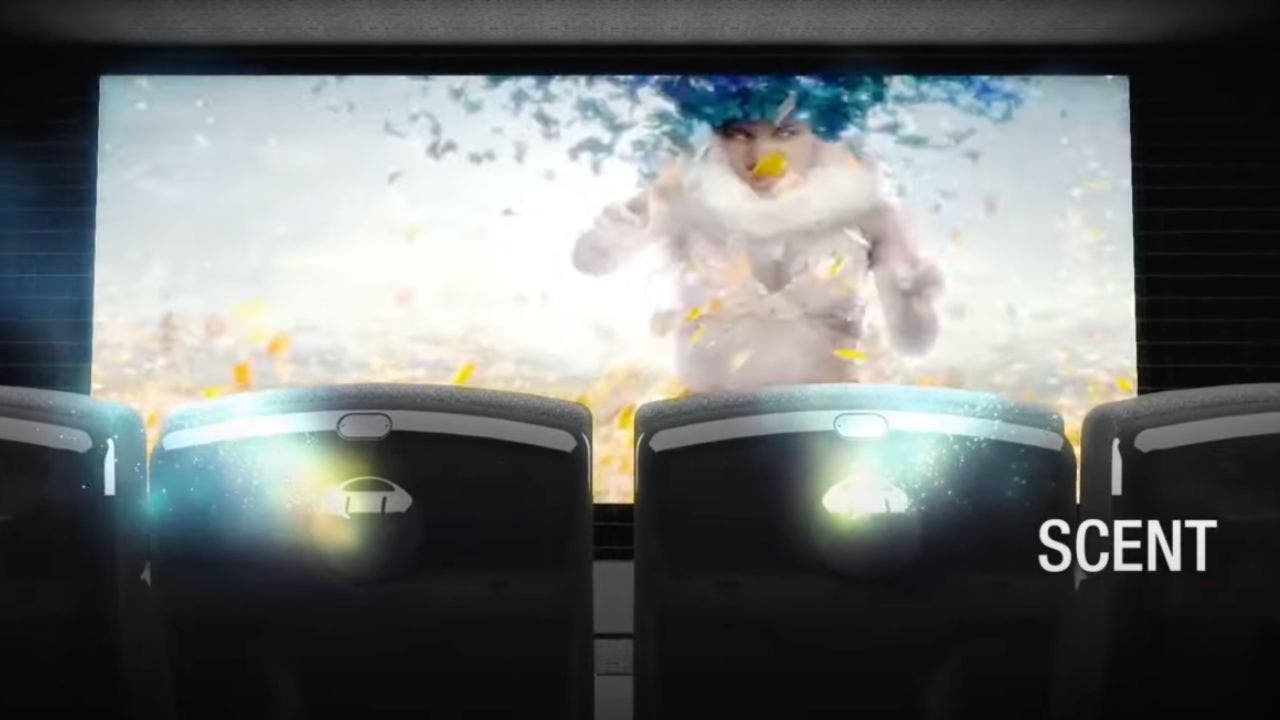For the past two weeks, I’ve been editing in the newest version of Final Cut Pro for the iPad. For many professionals, the original release of this app last year missed the mark. Its tools have just been too limited to use on a daily basis. The new version doesn’t necessarily change that — but despite my many frustrations, I’m finally discovering the joy of using it.
Technology
Can 4DX motion seats and sensory elements get you to return to the movie theater?

The onset of the pandemic changed the moviegoing experience for most Americans. Once a regular part of most Americans’ weekend plans, people quickly replaced it with streaming content at home.
A new type of moviegoing experience might bring people back to the theaters. It’s called 4DX, and it marries the cinematic experience with real-life elements.
So, in essence, you’re not just sitting there watching a movie; you’re part of it, engaging all of your senses.
GET SECURITY ALERTS, EXPERT TIPS — SIGN UP FOR KURT’S NEWSLETTER — THE CYBERGUY REPORT HERE
Multi-sensory cinema technology. (4DX)
What is a 4DX movie experience?
While options like Imax have been around, 4DX creates a multi-sensory experience that coincides with the film’s story. 4DX combines seat movements, effects and sensory elements to complement or enhance the movie being watched.
For instance, if the character in the film is traversing a foggy landscape, the fog would be released in the actual theater. If the movie shows certain movements, those movements might be echoed by the motion of the seats. If the characters are experiencing certain smells, scents might be released to give viewers a sensory experience as opposed to just a visual one.
HOW TO CREATE YOUR OWN HOME MOVIE THEATER
16 effects of 4DX movie theater technology
1. Roll: The motion seats can roll side-to-side, immersing you in the action as vehicles turn or objects tumble. This rolling motion creates a visceral sense of centrifugal force and inertia.

Multi-sensory cinema technology. (4DX)
2. Pitch: The seats pitch forward and backward, recreating the sensation of acceleration, braking or falling. Pitching downward simulates the stomach-dropping feeling of rapid descents or free-falls.

Multi-sensory cinema technology. (4DX)
3. Sway + twist: The seats can sway from side to side and twist, allowing you to feel sharp turns, spins and other dynamic movements. The twisting motion enhances the realism of tight corners, corkscrew loops and other spiraling action sequences.

Multi-sensory cinema technology. (4DX)
4. Tickler: Built-in ticklers in the seats provide gentle sensations on your legs and ankles, mimicking crawling creatures or environmental effects. These tickling effects can startle and delight, adding an extra layer of tactile immersion.

Multi-sensory cinema technology. (4DX)
5. Vibration: Precise vibrations in the seats deliver realistic impacts and tremors, heightening the intensity of crashes, explosions and more. From subtle rumblings to jarring shakes, the vibrations make you feel deeply connected to the on-screen events.

Multi-sensory cinema technology. (4DX)
6. Warm air: Heated air blows from vents, recreating environments like deserts or conveying a sense of warmth. The warm breezes envelop you, making hot and arid scenes feel palpable.

Multi-sensory cinema technology. (4DX)
7. Rainstorm: A combination of rain, wind and fog effects envelop the theater during storm scenes for an immersive downpour experience. You’ll feel like you’re caught in the midst of nature’s fury as the tempest rages around you.

Multi-sensory cinema technology. (4DX)
8. Rain: Water nozzles simulate rainfall, whether a light drizzle or a heavy shower. From a gentle patter to a torrential onslaught, the rain effects soak you in the atmosphere.

Multi-sensory cinema technology. (4DX)
9. Snow: A snow simulation system produces realistic-looking snowflakes that appear to float down from above. You may find yourself mesmerized by the drifting flurries, chilled by their wintry presence.
10. Wind: Powerful fans generate gusts of wind that can range from gentle breezes to intense gales. The forceful winds whip around you, heightening the drama of storms or aerial sequences.

Multi-sensory cinema technology. (4DX)
11. Fog: A fog machine fills the theater with a misty haze to establish moody atmospheres or obscure visibility. The swirling fog enhances the tension and mystery, limiting your sightlines just like the characters.

Multi-sensory cinema technology. (4DX)
12. Strobe: Intense strobe lighting flashes in sync with events like lightning strikes, gunfire or explosions. These blinding bursts of light amplify the shock and awe of high-impact moments.

Multi-sensory cinema technology. (4DX)
13. Bubble: Bubble effects create a buoyant underwater ambiance for aquatic scenes. You’ll feel immersed in the underwater realm as the bubbles float around you.

Multi-sensory cinema technology. (4DX)
14. Scent: Scent emitters release various aromas matched to the environments and situations on screen. From the earthy smell of a forest to the acrid odor of smoke, the scents deepen your sensory connection.

Multi-sensory cinema technology. (4DX)
15. Water: Water jets can spray the audience, mimicking splashes, waves or characters getting wet. Prepare to get a little damp as the water effects make you feel like you’re right in the thick of the action.

Multi-sensory cinema technology. (4DX)
16. Face air: Focused air nozzles blow air bursts directly at viewers’ faces for sudden, startling sensations. These in-your-face blasts of air will catch you by surprise, amplifying jump scares and intense moments.

Multi-sensory cinema technology. (4DX)
HOLLYWOOD HIJACKED: THE AI TAKEOVER OF TINSELTOWN’S FILMS TO FAKE OUT AMERICANS
Are 4DX movie tickets worth the extra bucks?
While more expensive than a regular movie ticket, about $8 more, so a ticket could range from $20 to $30, it seems the value proposition is there for both the theaters and the viewers. With elements that allow you to smell and feel alongside the movie, which cannot be replicated at home, it gives viewers a reason to head to the theater instead of streaming. Theater owners are able to make more per ticket than with non-4DX releases.
Regal is the largest operator of 4DX, with 50 of the 62 locations in the U.S. and Canada and 750 globally. Last year, 4DX programmed more than 100 films, 40 to 45 of which were major Hollywood titles.
The 4DX programmers work really hard to pull this all off. They take two to three weeks to create the experience that enhances the moviegoing experience. Between the fog machines, sound systems and sensory elements, they create original and unique experiences that immerse viewers.
HOW TO CREATE YOUR OWN MARVELOUS OUTDOOR MOVIE THEATER
Kurt’s key takeaways
I don’t think I want to take a squirt of water to the face, but 4DX movie theater technology has to be experienced to understand how amazingly compelling film watching is elevated to something unforgettable. While some moviegoers may embrace this innovative approach with open arms, others might find the sensory overload overwhelming, especially during intense action sequences or startling moments.
It’s the best shot movie theater operators have to wow the audience back to the big screen. In an era where streaming services have become increasingly popular, 4DX offers an experience that simply cannot be replicated on a phone, a tablet screen or at home. The combination of motion seats, environmental effects and sensory stimuli creates a truly captivating atmosphere. As the technology continues to evolve and refine, it will be interesting to see how 4DX shapes the future of moviegoing.
After learning about the immersive and multi-sensory experience offered by 4DX, does this pique your interest? Or do you find the idea of it all could be overwhelming and potentially detracting from the movie? Let us know by writing us at Cyberguy.com/Contact
For more of my tech tips and security alerts, subscribe to my free CyberGuy Report Newsletter by heading to Cyberguy.com/Newsletter
Ask Kurt a question or let us know what stories you’d like us to cover.
Follow Kurt on his social channels:
Answers to the most-asked CyberGuy questions:
Copyright 2024 CyberGuy.com. All rights reserved.

Technology
How Apple is trying to make Final Cut Pro a “touch-first” video editing app
/cdn.vox-cdn.com/uploads/chorus_asset/file/25500699/DSCF7644.jpg)
The new version of the app, confusingly named “Final Cut Pro for iPad 2” (it is for all current iPads, not the iPad 2), came out this week. And perhaps the biggest new feature in this year’s release isn’t entirely a Final Cut Pro feature: it’s a brand-new app that integrates with it.
The new Final Cut Camera is a standalone app for your iPhone that offers advanced camera controls. If you’ve seen the Blackmagic app or the recently released Kino app, you’ll know what to expect: peaking, manual focusing, and audio metering. You just won’t be able to add custom LUTs like you can in the other two.
The Final Cut Camera app can be used in unison with Final Cut Pro on the iPad to record Live Multicam sessions with footage streaming in from up to four iPhones or iPads. In Final Cut on the iPad, you assume the role of director. You can monitor footage coming from iPhones, zoom in, and change the white balance, focus mode, and more on the fly. I can see this new feature being particularly popular for video podcasts.
The previews you’re seeing are compressed, but they still look great. Once you stop the recording session, the full-quality files get transferred over to the iPad running Final Cut Pro and rendered. The whole process is a lot faster than I anticipated. My 10-minute session with three iPhones was available for editing minutes later. A new transfer indicator window on the top of the UI shows you the progress.
There’s one upgrade I’d love to see for this feature in the future: live editing. Currently, you’ll still need to end the recording first before syncing up all files and jumping into the edit.
Multicam support is a great new feature, but it contrasts with how little else Apple has done to improve the Final Cut Pro for iPad experience. The standout feature in this year’s update is external hard drive support. That’s important — this feature was oddly absent last year. But its addition instantly reminded me of how poorly Final Cut Pro for iPad (and iPadOS) handles file management.
All of your media files have to live within the FCP Library files, and that same library file has to be stored on either the internal or external drive. That means you can’t split your media across multiple drives or cloud storage. One side effect of this method is that it means you’re just constantly duplicating files from one place to another.
And there are other issues that haven’t changed from last year. For example, you still can’t import complete folders into Final Cut Pro, just individual files. And once they’re imported, you still can’t organize the files into separate folders or bins like “A-roll,” “B-roll,” “Music,” or “Graphics.”
Another new feature that’s unique to the iPad version of Final Cut Pro is Live Drawings. Using an Apple Pencil, you can draw animations directly onto your clips. Apple’s latest Pencil Pro tricks are supported here, but aside from that, there’s not much to do with the Pencil Pro itself. I wish there was a way to program the haptic squeeze to do something more on the editing front — maybe selecting multiple clips while hovering, or just make it a right-click. I feel like that would be useful and would speed up working with a pencil.
There are still a lot of serious video editing features that I’m waiting on Apple to add: compound clips, folders, adjustment layers, post stabilization, coloring tools like curves, project sharing between machines, the ability to add new LUTs, 360 video support, object tracking, linear keyframes — the list goes on and on. If you read my review from last year, you’ll find the exact same list there.
All of those missing things really catch you off guard when you are in the flow. Ultimately, I found myself making creative decisions based on bad software limitations.
Meanwhile, the market for mobile video editing apps is more competitive than ever. CapCut has been extremely popular among TikTokers. “Why I’m switching to DaVinci” videos are all over my YouTube feed. And folks still stan the OG iPad app Lumafusion. In fact, three of the features I desperately need are already on the DaVinci’s iPad app.
But even after trying all of the other apps I just listed and even with all my frustration with the missing features, I keep coming back to Final Cut on the iPad. Because there is one thing Apple is doing right here, and that’s the overall experience.
Apple calls this a “touch-first” app, and I finally understand what that means. Once you’re past the learning curve and once you get a hang of the controls and once you’re aware of its limitations, you start to actually enjoy it and have fun. Apple isn’t trying to replicate the Final Cut desktop experience — it’s building toward a new one. And you can see in the way you interact with the jog wheel and the way that the sidebar comes in so you can edit with your left hand.
I found that using the Final Cut Pro with my hands is by far the most immersive way to edit. It’s all right there at your fingertips, literally. There is something about this more tangible approach that I’m starting to find charming, even if it’s not as efficient as a mouse and keyboard.
If Apple can check off those easy wins, then its vision of a capable and touch-first Final Cut Pro could really thrive.
Photography by Vjeran Pavic / The Verge
Technology
Twitch banned Dr Disrespect after viewing messages sent to a minor, say former employees
/cdn.vox-cdn.com/uploads/chorus_asset/file/25502063/1965814485.jpg)
Twitch abruptly banned one of its biggest stars — Herschel “Guy” Beahm, better known by his persona Dr Disrespect — in 2020 without a word of explanation. Now, four years after Beahm’s permanent ban, two former Twitch employees have come forward to describe events they say contributed to his removal from the platform.
One former Twitch employee, who asked to remain anonymous citing the potential risk to their career, told The Verge that Beahm had used Whispers, Twitch’s now-defunct messaging system, to exchange messages with a minor and initiate a conversation about meeting up at TwitchCon. The employee worked on Twitch’s trust and safety team at the time of the ban in 2020.
Their comments corroborate a post from Cody Conners, a former Twitch employee who worked on the company’s strategic partnerships team. Late Friday, Conners posted on X, “He got banned because got caught sexting a minor in the then existing Twitch whispers product. He was trying to meet up with her at TwitchCon. The powers that be could read in plain text.”
Though Conners did not explicitly name Beahm, it was understood the streamer was the subject of the post. Beahm’s ban came shortly after Twitch updated its sexual harassment policy to punish offenders with permanent suspensions.
Beahm denied Connors’ allegations. “This has been settled, no wrongdoing was acknowledged, and they paid out the whole contract,” he posted on X. Beahm published an additional post reiterating that no wrongdoing was found. “I didn’t do anything wrong, all this has been probed and settled, nothing illegal, no wrongdoing was found, and I was paid,” he wrote.
The news of Beahm’s ban, which came down four years ago this week, was shocking. Beahm was one of Twitch’s most popular stars at the time, with around 4 million followers, and he had just signed a seven-figure, two-year exclusivity contract with the platform. Neither Twitch nor Beahm would say why the streamer had been banned. In an interview with The Washington Post shortly after the ban, Beahm said that Twitch wouldn’t even tell him the reason why his account had been removed.
The former employee who spoke with The Verge also shared more insight into the order of events that led to the ban. They said there was a significant amount of time between when the messages between Beahm and the alleged victim were sent and when the moderation report about those messages was filed, but they weren’t able to recall how much time. When Twitch received the report in 2020, they said that Twitch investigated the claims and ultimately banned Beahm’s channel.
A year after being banned, Beahm said he was suing Twitch for monetary damages and disclosed that he finally knew why the platform issued the ban. However, Beahm declined to say what that was. A year later, the dispute was resolved with Beahm saying, “I have resolved my legal dispute with Twitch. No party admits to any wrongdoing.”
Beahm and Twitch did not respond to The Verge’s requests for comment.
Technology
Your car is a target — don’t get hacked or duped

Ever heard of wrapping your key fob in aluminum foil? It sounds out there, but it’s a smart move.
Join 509,000 people who give this free tech newsletter a 4.92/5 star rating.
Sign up now and don’t be left behind.
Your key fob’s signal is surprisingly easy for criminals to intercept. That lets them open your car without setting off any alarms. If you have a true keyless car model, they might be able to just drive away. Wrapping it in foil blocks the signals.
It’s no surprise your car is a target. It’s probably one of the most valuable things you own. Let’s look at a few scams right now targeting car owners and those shopping for a new ride.
X, FORMERLY TWITTER, IS TURNING ON PORN — BUT YOU CAN BLOCK IT
Cloned VIN scam
A Boston woman paid around $40,000 for an SUV on Facebook Marketplace. The Carfax report looked legit, and Maril Bauter received a clean title from the licensing agency. It was smooth sailing for almost three years … until the police seized the vehicle.
When she bought the 2019 Toyota 4Runner, it was stolen. Bauter was the victim of a VIN cloning scam.
It all starts with a stolen car or perhaps one totaled out by an insurance company. The scammer finds the same make, model and year and takes the VIN from that car. It’s as easy as snapping a picture through the windshield.
The scammer then changes the VIN plate on the stolen or totaled vehicle to match the one on the clean vehicle. Now, the scammer can create fake documents and complete the sale.
Unfortunately, it’s hard to spot these scams. If you’re in the market and buying from a private seller:
- Use a site like Carfax or AutoCheck to look for anything strange with the VIN.
- Compare the VIN on the car (near the windshield and in the door) with the title and all the other documents the seller provides.
- Look for signs the VIN plate has been switched out. Run your finger over that area.
- Consider paying a mechanic or car inspection service to look for major issues or red flags.
Bauter’s story had a happy ending: Her insurance company paid out her claim on the stolen vehicle. That said, not every victim is this lucky so be sure to do your due diligence if you’re in the market for a new vehicle.
HANDY HIDDEN FEATURES ON INSTAGRAM, X AND FACEBOOK
Check out a recent Kim Komando Podcast episode: Insurance companies use drones to look at your home
Not the only car scam on Facebook Marketplace
An 18-year-old was arrested in Fort Lauderdale for posting his neighbors’ cars for rent on FB Marketplace. The scammer collected deposits and then sent renters to the car owners’ real addresses.
One neighbor said eight people showed up at her house over three weeks. Another got his car smashed by an angry would-be renter.
- Never, ever pay ahead for a rental through a community sales platform. Really, it’s best to stick with a legitimate rental company.
A throwback attack
Cybercriminals can also employ old-school denial-of-service attacks to overwhelm your vehicle and potentially shut down critical functions like airbags, anti-lock brakes and door locks.

(ISSOUF SANOGO/AFP via Getty Images)
This attack is feasible since some connected cars have built-in Wi-Fi hotspot capabilities. As with regular home Wi-Fi networks, they can even steal your data if they infiltrate your car’s local network.
Also, it’s a matter of physical safety. Remember, multiple computers and Engine Control Modules run modern cars. If hackers can shut these systems down, they can put you in grave danger.
- Regularly changing your car’s onboard Wi-Fi network password is a must. Turning off your car’s Bluetooth and Wi-Fi is also a good idea when not in use, too.
The built-in monitoring is a security risk, too
Every newer car has an on-board diagnostics port. This interface allows mechanics to access your car’s data, read error codes and statistics and even program new keys.
Anyone can buy exploit kits that can utilize this port to replicate keys and program new ones to use them for stealing vehicles.
AI EXPERT: CHATGPT PROMPTS YOU’LL WISH YOU KNEW SOONER
- Always go to a reputable mechanic. A physical steering wheel lock can also give you extra peace of mind.
Mobile malware
Another old-school internet hack reaches connected cars, specifically models with internet connectivity and built-in web browsers.

A woman working on her laptop (Kurt “CyberGuy” Knutsson)
Crooks can send you emails and messages with malicious links and attachments that can install malware on your car’s system. Anything is possible once the malware is installed. Car systems don’t have built-in malware protections (yet), so this can be hard to spot.
- Practice good computer and internet safety even when connected to your car. Never open emails and messages nor follow links from unknown sources.
Get tech-smarter on your schedule
Award-winning host Kim Komando is your secret weapon for navigating tech.
Copyright 2024, WestStar Multimedia Entertainment. All rights reserved.
-

 Politics1 week ago
Politics1 week agoRule of law on ballot in NYC suburbs as cop, veteran trade barbs over border crisis, policing
-

 News1 week ago
News1 week agoIt's easy to believe young voters could back Trump at young conservative conference
-

 World1 week ago
World1 week agoSwiss summit demands 'territorial integrity' of Ukraine
-

 News1 week ago
News1 week agoJustice Department won't pursue contempt charges against Garland
-

 World1 week ago
World1 week agoSwitzerland's massive security effort at the Ukraine peace conference
-

 Politics1 week ago
Politics1 week agoBiden looks to capitalize on star-studded Hollywood fundraiser after Trump's massive cash haul in blue state
-

 News1 week ago
News1 week agoJoe Biden, Barack Obama And Jimmy Kimmel Warn Of Another Donald Trump Term; Star-Filled L.A. Fundraiser Expected To Raise At Least $30 Million — Update
-

 Politics1 week ago
Politics1 week agoJudge rules Missouri abortion ban did not aim to impose lawmakers' religious views on others















